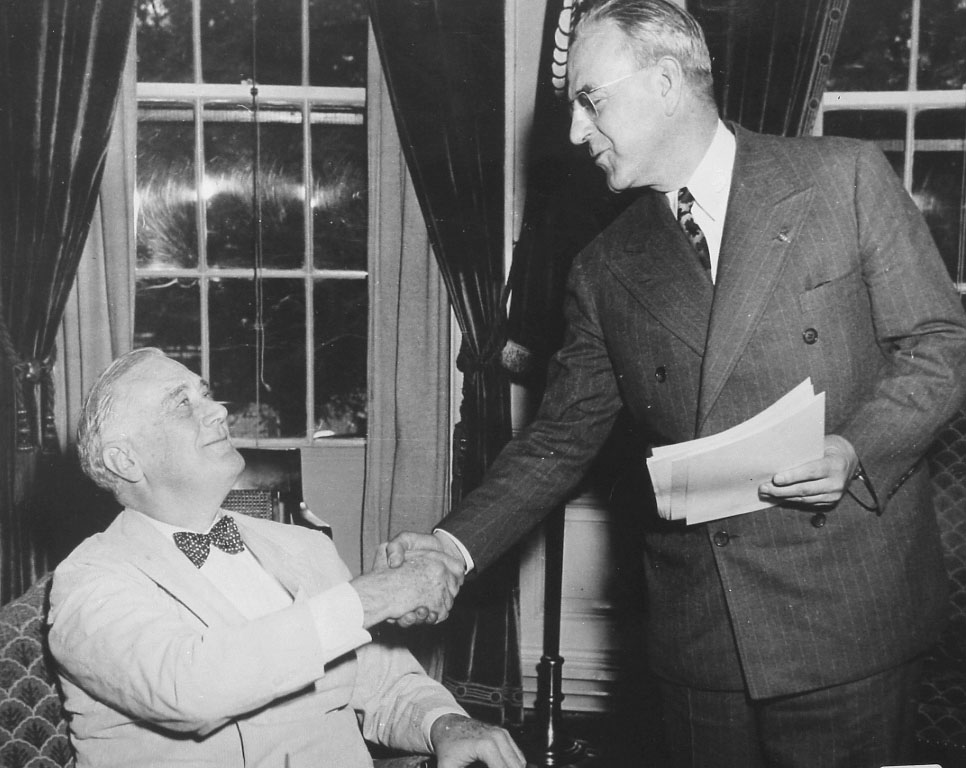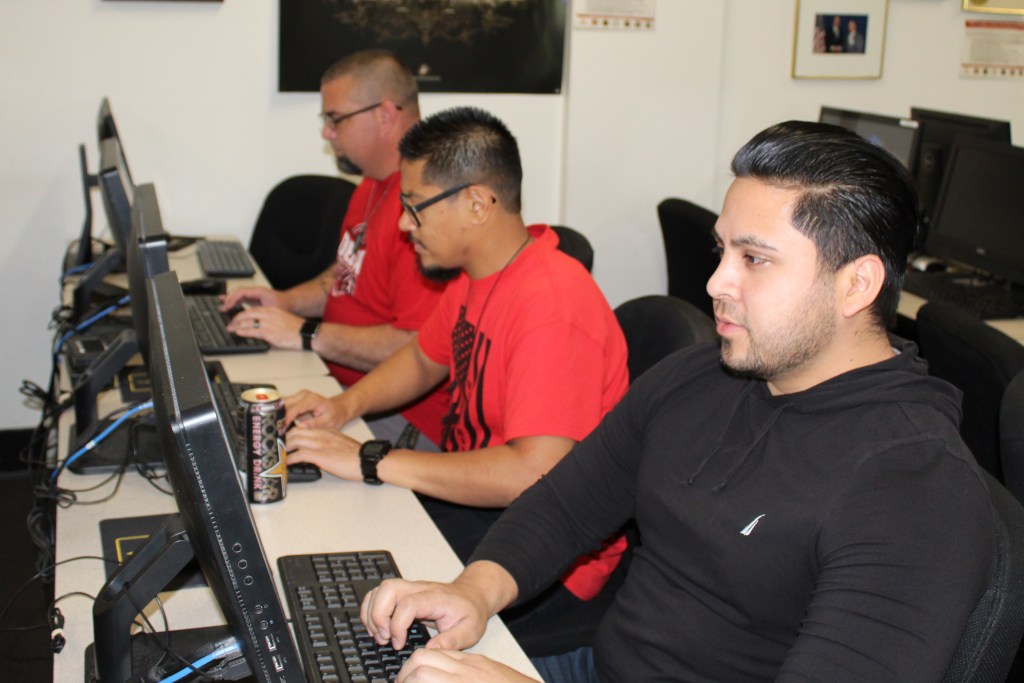Like so many others who left the military for civilian life, Arthur Matedne wanted to return to college. The Navy veteran from Stockton was aware of the GI Bill and that he should take advantage of his earned benefits, but knew little about them. “Not a lot at all,” said Matedne, a 32-year-old who spent four years as a hospital corpsman. “I didn’t start using them for a long time. I stayed home the first year-and-a-half after I got out.”

Courtesy of the Bank of Stockton Historical Photograph Collection
Eventually, he went to the Leo P. Burke Veterans Resource Center at San Joaquin Delta College in Stockton, where 388 veterans, along with six dependents of veterans, currently are certified to attend classes on the GI Bill. The center is where military service members, veterans, and their families, come to inquire about their available GI Bill benefits and to begin navigating the certification process. They are frequently assisted by other veterans, including Matedne, who now guides them through it, just as other veterans helped him when he first arrived on campus.
John Ervin, Delta’s Veterans Resource Center manager, believes the college possesses perhaps stronger ties to the GI Bill than any other college in the state. How so?
About the length of a football field across campus sits the 1,400-seat Warren Atherton Auditorium. It bears the name of the man who in essence wrote the legislation that became the Servicemen’s Readjustment Act, known as the GI Bill, and was signed into law by President Franklin D. Roosevelt on June 22, 1944 – 75 years ago this week.

Atherton worked in a Stockton law office from 1911 until he left to serve under General John J. Pershing during World War I. He returned to Stockton when the war ended and married the daughter of Benjamin Holt, founder of Caterpillar, Inc. He served as general counsel for the California Department of Veterans Affairs (CalVet), and its boards and commissions from 1935 until 1960.
But his legacy is the GI Bill. Several iterations later, the GI Bill provides service members, veterans, and their families not only with pathways for obtaining higher education, but also with a Basic Allowance for Housing or BAH, that enables them to pay the rent and put food on the table while doing so. It can also provide benefits to their spouses and dependent children, if the service members elects to transfer the benefit prior to separating from the service. Other educational benefits provide monthly stipends directly to qualified veterans’ dependents as well.
The original GI Bill didn’t happen without a fight, though. Atherton, who also served as the national commander of the American Legion, had to overcome opposition by Rep. John Rankin. The Mississippi Democrat and segregationist at first co-sponsored the bill, but then opposed it. He claimed African-American veterans would abuse the bill, using it simply as a form of welfare. He also didn’t think African-American veterans deserved the same benefits as whites. Atherton chastised him for delaying the proceedings, and the House overrode Rankin to pass its version of the bill after the Senate already had done so. But Rankin did get a major concession that turned control of its implementation over to state and local levels. In many states, this led to discrimination against African-Americans who served and wanted to seek higher education. That, in turn, became a contributing factor to the civil rights movement of the 1960s.
Women veterans were also eligible for benefits, but found barriers to utilizing the GI Bill as well. Like African-American men veterans, women veterans were subjected to caps on admissions by race and gender at colleges and universities. Additionally, women veterans were often incorrectly told that they were not eligible for GI Bill benefits.
So while the GI Bill became a huge driver in the American economy in the post-World War II years — its education and VA Home Loan programs are credited with helping create a thriving middle class into the early 1960s – some veterans encountered barriers, due to racial and gender discrimination.
The bill has been updated as the Montgomery GI Bill in 1984, and again with the Post-9/11 GI Bill in 2008. The latter allows the transfer of benefits to veterans’ spouses or dependent children.
That a Stockton man played such a pivotal role in the original bill’s existence is a source of pride John Ervin loves to share with the veterans who come to the center. When actor Kevin Dobson brought his production of the one-man show titled “The American Soldier,” Ervin booked it for the Atherton Auditorium, and did the same when a memorial to the Marines’ Lima Company titled “The Eyes of Freedom” came to the campus in 2018.
As of November 2018, there is no time limit for using the benefits after leaving the service. The Harry W. Colmery Veterans Educational Assistance Act, also known as the “Forever GI Bill,” expanded the bill’s benefits while eliminating the 15-year timeframe during which they had to be used.
“In about an hour, we can show them what types of benefits they are eligible for and teach them how to navigate the (federal VA’s) eBenefits portal,” said Ervin.
Chelan Yanez, 28, is a native of Washington state, a Marine Corps veteran and mom of three children, ranging in age from two to six years. She served in Okinawa, among other posts, and her veteran husband, Alexander, is now a Stockton police officer.
“He used the GI Bill going through the (law enforcement) academy,” she said. Chelan is also using her GI Bill benefits, which are separate from her husband’s. “I’ve got mine, he’s got his.”
Veterans, she said, must understand that the process isn’t instantaneous – that they won’t immediately have a check in hand. “They are not going to get a check until about a month after (certification).”
The book stipend is vital, she said. “Getting reimbursed $500 or $600 for books is huge. “Being very poor and stressed out – I don’t think people exactly understand that until they’ve been through it.”
Jeremy Caylor, 36, spent a decade in the Air Force. He served at Luke Air Force Base in Arizona, and in South Korea. He said beyond a Transition Assistance Program briefing while he was still in the military – and was “very minimal” — he learned most of what he now knows about the GI Bill at the Veterans Resource Center at Delta College.
“The longest part was waiting for the paperwork to come in the mail,” Caylor said. “But ‘hurry-up-and-wait’ is what they taught us in the military from day one.” It finally arrived, and he began working toward his associate degree in psychology, with plans to continue either at University of the Pacific or at California State University Stanislaus in Stockton.

Jeremy Caylor research GI Bill benefits at Delta College.
“The GI Bill is tremendous,” Caylor said, who is also married with a six-year-old son. “It made it so I could go to school without having a job or a side job.”
Consider it the nation’s way of saying “thank you” to service members, veterans, and their families for their sacrifice and for jobs well done. And the veterans at Delta College know they have an extra connection: The GI Bill exists in large part due to the gentleman whose name graces the theater just yards away and who played such a major role at CalVet.
For more information about selecting a California public school and to learn more about veterans benefits, visit CalVet’s California Transition Assistance Program (CalTAP) at https://www.calvet.ca.gov/VetServices/Pages/California-Transition-Assistance-Program.aspx.
To learn which programs are approved for GI Bill benefits in the state of California, visit https://www.calvet.ca.gov/CSAAVE.
For information about the GI Bill and VA educational benefits, visit https://benefits.va.gov/gibill. #�
For information about approved for-profit schools, visit https://www.calvet.ca.gov/CSAAVE
